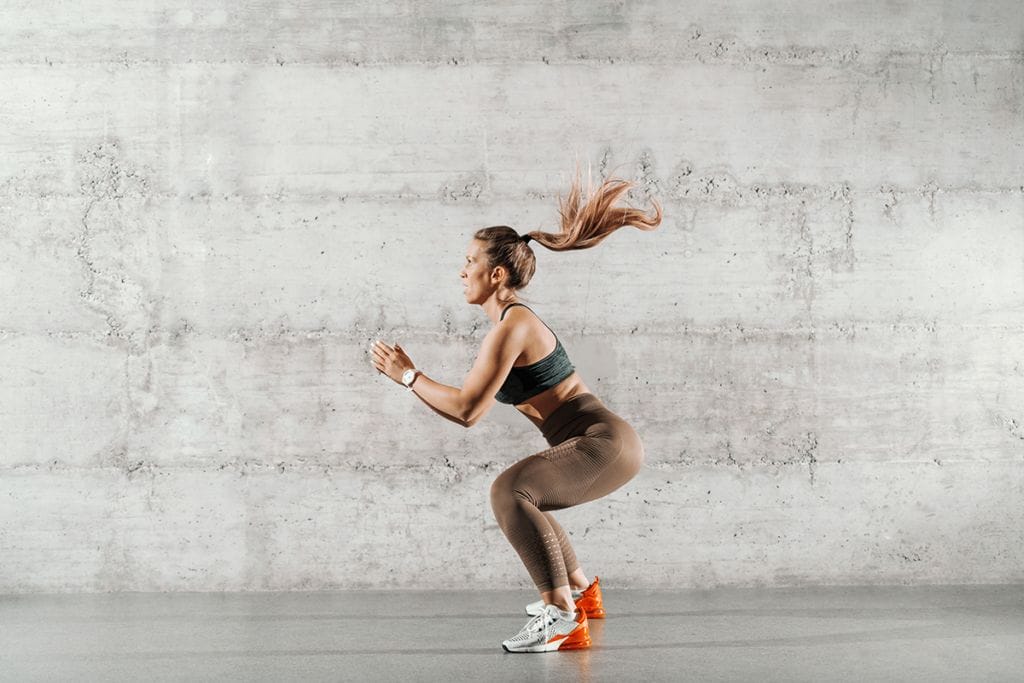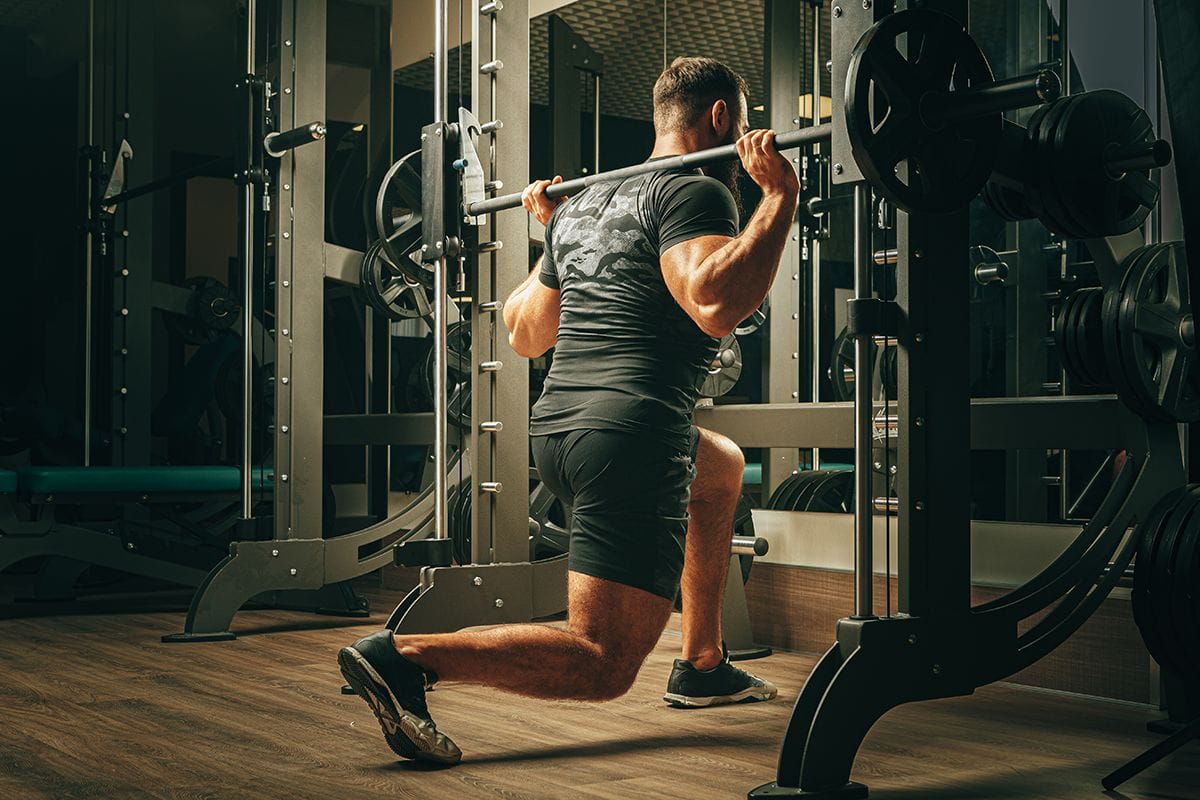Two significant movements are widely used to assess athletic performance: the countermovement jump and the squat jump.
Among these, countermovement jump performance tends to be superior to that of squat jump performance, and this has been attributed to the effective utilization of the stretch-shortening cycle.
What Is CMJ and Squat Jump Performance?
CMJ and squat jump are two standard measures of explosive strength in sports, especially in jumping events such as basketball or volleyball.
These tests typically involve measuring an athlete’s vertical displacement from a standing position using a force plate to quantify body velocity changes during an explosive movement.
Several studies have examined the validity of these measurements for predicting athletic performance outcomes such as sprint times or vertical leap distance, with results indicating moderate to high correlations.
It is essential to note that each athlete’s needs vary depending on their strengths and weaknesses, so it is best to consult with a coach or sports performance specialist to tailor a program specifically for you.
What is the stretch-shortening cycle?
The stretch-shortening cycle, or SSC, is a term used to describe the rapid changes in length and tension that occur within muscles during explosive movements like jumping or sprinting.
This phenomenon refers to the ability of specific muscles to absorb energy when stretched and then release that energy quickly when contracting back to their original length.
The SSC is widely considered an important mechanism for improving athletic performance, as it can help increase strength, power, and speed.
Several training techniques can enhance the SSC, including plyometric exercises, strength training with heavy loads, and ballistic movements such as jumping. However, optimal results are often achieved by using a combination of these methods to target all the major muscle groups involved in the SSC.
How does the stretch-shortening cycle contribute to athletic performance?
The stretch-shortening cycle is a dynamic process that occurs when muscles lengthen and then shorten in rapid succession. This cycle plays a vital role in athletic performance, as it can help generate greater force and power.
When muscles lengthen (eccentric contraction), they store energy in the form of elastic potential energy. This stored energy can then help power the muscle during the subsequent shortening phase (concentric contraction).
Therefore, the stretch-shortening cycle provides a mechanical advantage that can help improve athletic performance.
In addition, the stretch-shortening cycle has been found to enhance coordination and motor control. This is likely because eccentric contractions help prepare muscles for the subsequent concentric contraction, and shortening contractions help prime muscles for the subsequent lengthening movement.
Overall, the stretch-shortening cycle is a critical component of athletic performance.
What is the difference between maximal and explosive strength?
Maximal strength refers to the highest amount of force that a muscle can produce, while explosive power refers to the ability to generate that force in a brief period of time.
Both are important for athletics, as they play a role in everything from sprinting and jumping to throwing and hitting. However, explosive strength is often considered more important for sports that require quick bursts of power, such as football or basketball.
The differences between maximal and explosive strength can be explained by looking at the underlying physiological mechanisms that drive each type of strength.
Maximal strength primarily relies on the muscles’ ability to generate force over an extended time, often with heavy loads or resistance.
This requires high levels of muscular endurance and the use of slow-twitch muscle fibers, which are better suited for sustained contractions than fast-twitch fibers.
On the other hand, explosive strength is more reliant on the muscles’ ability to generate force quickly, often in response to a sudden stimulus like jumping or sprinting.
This type of strength requires fast-twitch muscle fibers, which are better equipped for quick, powerful contractions.
It is also worth noting that explosive power is heavily dependent on the nervous system’s ability to deliver signals to the muscles quickly and efficiently.
Ways to Improve Squat Jump Performance
There are many ways to improve your squat jump performance. One way is to increase the weight you lift in the squat, which will make it easier for you to produce more power when you jump because of more significant strength development.
Another way is to focus on improving your form since a proper technique can significantly enhance your abilities in this area by giving you a better foundation that allows you to use all the muscles involved in jumping optimally.
Many people also find that improving their flexibility and balance helps them achieve more extensive results while they work on increasing their squat jump performance.
If you’re looking for an easy and effective way to start improving your performance in this area today, try incorporating one or more of these strategies into your workout routine and see how quickly you can start seeing results.
Of course, it may take some trial and error to find what works best for you specifically, but with enough effort and patience, there’s no doubt that you’ll be able to achieve better results in no time.
Try implementing these tips into your workout routine today, stay focused on your goals, and see how quickly you can start seeing improvements in your squat jump performance.
Ways to Improve Countermovement Jump Performance
When looking at how your body moves, you will notice that it performs a series of movements and adjustments before jumping.
One crucial movement for improving your performance is called the countermovement jump. This involves bending forward at the waist and knees before springing upward with both feet into a jump, landing, and then performing another countermovement jump.
You can do several things to help improve your performance during this type of movement. These include warming up thoroughly before performing the exercise, focusing on stretching and strengthening muscles, adding resistance training exercises, and performing other plyometric movements needed for fast movements while increasing the power output required by the muscles.
Warming Up
The first step in improving your countermovement jump performance is to warm up thoroughly before beginning the exercise. This will help ensure that all joints and ligaments are loose and flexible, minimizing the risk of injury during this activity.
Some good ways to warm up include stretching or performing dynamic stretches such as arm circles or leg swings. Additionally, try adding some light cardio exercises such as jogging or cycling to get your body moving and increase blood flow through your muscles before performing the exercise.
Stretch and Strengthen the Muscles
Another important tip for improving countermovement jump performance is to strengthen and stretch the muscles used during this exercise. These include the quadriceps, hamstrings, glutes, and calves.
Perform regular static stretches such as toe touches or hamstring stretches to keep these muscles flexible.
In addition to warming up and stretching properly, another way to improve your countermovement jump performance is to add resistance training exercises into your workout routine.
Try incorporating exercises such as weighted squats, lunge presses, and deadlifts into your routine a few times per week. This type of exercise helps build muscle endurance which is important for jumping activities.
As you get stronger, you can increase the weight used for these exercises.
Plyometric Movements
Another great way to improve your countermovement jump performance is to perform other plyometric movements such as box jumps or frog jumps.
These movements help develop the power and explosiveness needed for successful jumping activities. Try adding 2-3 sets of 8-10 reps of these exercises into your workout routine a few times per week. Remember to warm up thoroughly before performing any type of plyometric exercise and to start with lower heights or distances before progressing to higher levels.
By following these tips, you can help improve your countermovement jump performance and make it easier to jump higher and further distances.
Practice these techniques regularly, and warm up properly before each workout session to help prevent injury. You should see a noticeable difference in your ability to jump higher and further distances with regular practice.
The benefits of improving CMJ
There are many benefits to improving your countermovement jump performance. These include increased power, explosiveness, and improved ability to jump higher and further distances. These can help you perform better in sports or other physical activities, making it easier to excel at competitions or high-intensity workouts.
Developing greater strength, flexibility, and endurance in the muscles used for jumping can also help reduce your risk of injury during these movements.
Overall, improving your countermovement jump performance can help you become a stronger athlete with greater speed and agility on the playing field and in the gym.




